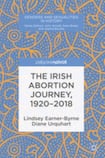
What is the history of this island when people, rather than nations, states or religion are put at the centre of the story? What is our history when you put the lives of the female population and their reproductive health at the centre? It is a history of scalding baths and falling down stairs in order to end a pregnancy. It is being doubled over in pain on the floor of Manchester airport after having an abortion. It is bringing your dead child through Dublin port in a cooler bag. It is dying unnecessarily.
Two historians, Lindsey Earner-Byrne and Diane Urquhart, have brought together decades of their own and others’ research on the history of gender in order to explain this story. In the summer of 2018, in the wake of the Repeal Campaign, they applied a historical lens to make sense of what they had just witnessed. In this concise, fluent and often devastating book, they ask why were the Republic of Ireland and Northern Ireland anomalous in the so-called “developed” world, as both refused to legislate for abortion.
Often conditioned to see the differences north and south of the Border, this history stresses the similarities. While unionist governments were committed to keeping welfare benefits on par with the rest of the United Kingdom, this did not pertain to the area of health, and neither the UK's 1929 abortion legislation, nor the 1967 Abortion Act, were extended to Northern Ireland. With the benefit of a long view and an all-island approach a clear picture emerges. On both sides of the Border there was an ardent desire to maintain an image of sexual purity and a sense of moral superiority. Political identities, infused with religion, required the marginalisation and exclusion of women and girls who might threaten them. This book demonstrates how this treatment was not a side show to the island story – it was an integral part of it.
Moral absolutism
The authors identify the decisions taken, and avoided, that resulted in restricted, or a denial of, access to contraception and abortion. Beginning in the 1920s it reveals how it was fully understood that the cost of moral absolutism in relation to birth control, and later abortion, would cost some women their lives. In the 1930s, the League of Nations, in a maternal welfare report, advised that women who suffered from conditions such as heart disease and tuberculosis should be provided with “anti-conception” advice. A Catholic medical organisation lobbied the southern Irish government to have the wording changed. The League of Nations responded that it was not advocating the “indiscriminate use of contraception”, but merely wished to ensure that women were not “called upon to sacrifice their lives”. The Irish government insisted that while such women should be made aware of the dangers, they should not be provided with advice on avoiding pregnancy. This intervention needs to be considered in the context of the high rates of tuberculosis in the State.
In Northern Ireland, a grey area produced by British case law, which indicated it was not legal to refuse to perform abortion for “religious reasons” when women’s health required it, allowed for Northern Irish doctors on a case-by-case basis to decide when an abortion was necessary and legal, making for an incredibly restrictive regime. By not extending the 1967 Abortion Act, a decision was made to maintain this status quo. This left agency, and legal risk, with doctors rather than women, and so women from both jurisdictions travelled, and travel, to Britain. From the 1920s this movement had allowed conservative commentators to boast of low illegitimacy rates and high moral standards. There was more than indifference towards those who made the journey; as the authors note, both states actually worked to make these journeys harder. The hardship was more severe for raped, ill, poorer, rural and asylum-seeking women and girls.
Feminist networks
What emerges in this compelling book is how the status quo loves silence and ambiguity. Lack of clarity in the law and the censorship of information put the onus on women to find individual solutions; their personal testimony would be key to the Repeal campaign. As one woman recalled, “I knew about the numbers of women who travel, but I also felt like the only one in the world.” The importance of female and feminist networks in informing and supporting women in this void also comes through. Earner-Byrne and Urquhart lay out the players and the reasoning that prevented reform and, given the live nature of this issue in Northern Ireland, the impact is chilling. They argue the importance of the 1983 pro-life amendment in making abortion a public and recurring issue of debate in the Republic of Ireland, providing the context for the long road to the 2018 referendum. Recent legislative developments in Westminster are a major victory for campaigners north of the Border, but how abortion services will operate there is not yet clear. It remains to be seen if women will be put in the centre of the story of Northern Ireland.
Carole Holohan is assistant professor in modern Irish history at Trinity College Dublin










